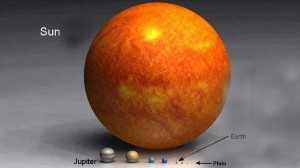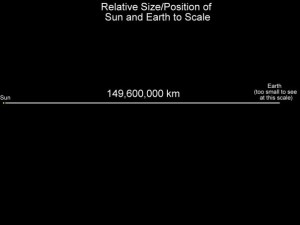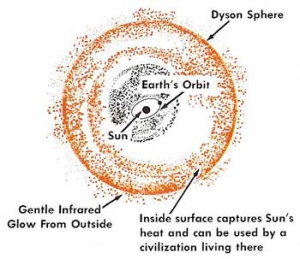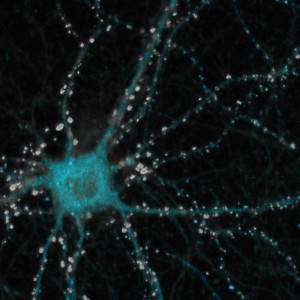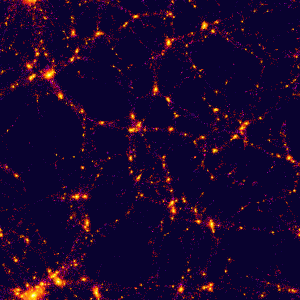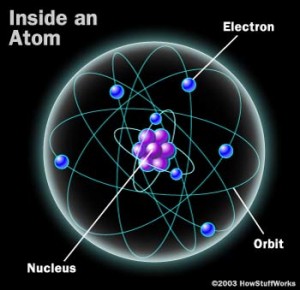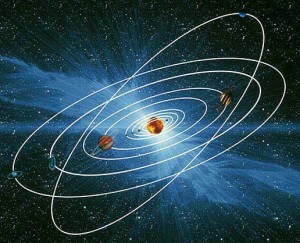A Dyson Sphere is probably one the largest artificial constructs ever imagined. What is a Dyson Sphere? There are a few variants on this idea proposed by Freeman Dyson. The variant of particular interest to me is the “shell” variant; a structure completely encapsulating a star so that all of it’s energy can be harnessed. The Dyson Sphere not only encapsulates a star, it also extends past the distance of the earth’s orbit around the sun.
Let’s get some perspective on this. The sun is massive. You could fit 1.3 million earths inside of our sun. Here is a picture to scale that shows the earth and the sun. Keep in mind the distances to the planets are NOT to scale. You may have to enlarge the photo to see the earth.
As I mentioned above, the distances of the planets from the sun is not to scale in the photo above. It is actually impossible to show both the sizes and distances to scale in one photo and still be able to see our planet. Here is a picture of earth’s orbital distance to scale.
Here is a scale diagram of a Dyson Sphere. The Dyson Sphere is an absolutely GARGANTUAN structure!
Why build something like this? Every second the sun produces enough energy to supply ALL of earth’s energy needs for 500,000 years. Imagine that. If we were able to harness all of the energy from our sun for only 1 second, human kind would not have to produce any energy for 100s of 1000s of years.
How Do We Build a Dyson Sphere?
Using conventional means of construction would be out of the question when tackling the engineering feat of building a Dyson Sphere. There is simply not enough matter on earth to create a sphere millions of times bigger than earth. If we combined all of the rocky planets in our solar system, there would still not be enough matter.
There was a Star Trek episode titled “Relics”, where the crew of the Enterprise encountered a Dyson Sphere. Their sophisticated sensors did not detect the structure because of the immense gravitational distortion it caused. Unlike a star or black hole, a Dyson Sphere probably would not emit intense radiation. Present day humans and humans from the year 2368 would have a hard time detecting it.
The Enterprise ends up inside the sphere, see below. Notice how the interior becomes the living surface area with land, water and an atmosphere clinging to the inside “walls”. But why bring up Star Trek?
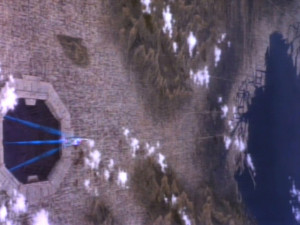
Star Ship Travels Inside a Dyson Sphere – an interior surface area equivalent to 200 million earths.
Besides being a fan of Star Trek, the science fiction inventions pioneered by the show hold the answer to creating a Dyson Sphere. Einstein gave us E=MC2 (squared). Matter and energy are the same phenomenon only in different forms. Like water vs steam. In the Star Trek universe (and in our future) humans master converting energy to matter and vice versa. They use a device called a replicator. It creates food, clothing, building materials and just about everything else from energy. This is scientifically possible, but we have not discovered exactly how to do this…yet.
Eventually human kind will invent replicators, devices that create solid matter from energy. We already have manufacturing robots that can create more manufacturing robots which can in turn, create more and so on. When you combine the concept of a replicator and a self duplicating machine, we are one step closer to creating a Dyson Sphere.
Millions of self replicating, solar powered devises or factories could be stationed in orbit around a star. All of the energy needed to power and create these devises would come from the host star. However, we would not need to start with millions of these devices. We could start with 1-100. They would self replicate and their numbers would increase exponentially. Now, with a limitless supply of energy/matter, we can begin the task of building the Dyson Sphere.
If we have thought of it, chances are, other intelligent life out there, maybe thousands or millions years ahead of us has already created it. Given the fact that there are hundreds of billions of stars in our galaxy and many more planets than that, I would bet intelligent life has arisen many times. There could be Dyson Spheres scattered through out our galaxy with trillions of life forms living inside.
